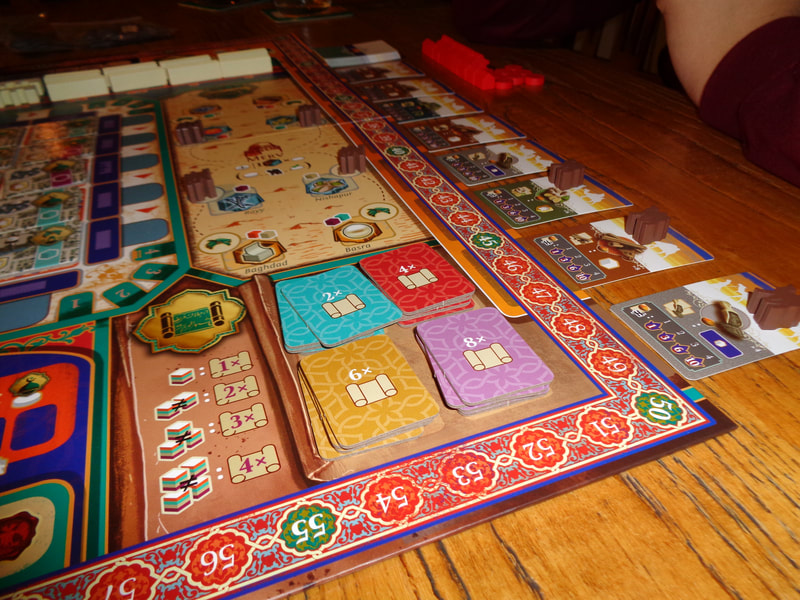|
7th September 2021 Tuesday evening is here and we're at The Sovereigns with the Woking Gaming Club. The first game of the night was Merv. What's in a game?
Despite its busyness, the game board is well illustrated and colourful, artwork on cards is also clear and colourful. For the most part the iconography is clear and easy to understand. Unfortunately, this does not extend to the symbols used to represent the game's 6 actions, these were a constant source of confusion and error. For example; the mosque action uses a minaret symbol but actually involves moving camel meeples along a track, but the symbols with camels on it is used to represent the caravansary! Why? Because the caravansary used camels to move spices! However, in game, the caravansary action only is used to get spices and has nothing to do with camels This means that camels are used to represent spices and minarets are used to represent camels! It verges on the ridiculous. It didn't help that all 6 symbols were the same colour so that it matched the colour theme of the board. How's it play? Setup
On to play Merv is played over 3 years and in each year there are 4 rounds, players have 1 action per round, thus 12 actions in total. Taking actions in Merv are quite unusual, play takes place around the 5x5 grid and each round takes place across 1 side of the grid (Starting on the north side.), then in the subsequent round, play moves clockwise to the next side of the grid and so on, so by the 4th round, a complete circuit will have been completed.
Endgame Once the 3rd year is over and has been scored, there is there final scoring to calculate. Sets of caravan cards score points. Points are tallied, highest score wins. Overall
Merv has several approaches to acquiring victory points but resource cubes is key to nearly all of them and the resource cube economy is very important. Acquiring cubes may conflict with choosing actions if the building site a player wants to activate produces cubes of a different colour, players will have to make choices and adapt. Having said that, it pays to diversify but it also pays to pursue one one strategy such as the caravansary or mosque track. Completing contracts feels like more of a bonus for sharp-eyed players than a long-term approach. Players also need to consider palace actions, placing workers into the right spaces in halls and moving along the favour track can be a good source of points. Players will need to also look towards defending Merv from attackers, losing buildings also loses the ability to gain resource cubes in later turns and of course loses victory points for the affected player(s). Merv is definitely on the heavier side of board games, but to be honest it didn't feel deep, just fiddly. I never got the feeling that I was making clever plays, instead I got the feeling that Merv was a heavy game made for the sake of being a heavy game. When I took an action, it often felt like I was doing 2 half actions instead of 1 whole one and it took multiple different actions to achieve something. E.g., I would undertake the marketplace action and acquire a good, Was I able to sell that good? No! What about spices, what if I'd acquired spices? Can't sell them either. To sell something, that is to complete a contract, I needed influence, which earned by building walls and also scrolls, which are acquired by visiting the library. Of course I also needed resources cubes. I know that some people will love this idea but I found it unengaging and a little dull and verging on tedious. Merv feels a little dry, unexciting and detached.
0 Comments
Leave a Reply. |
AuthorI play, I paint. Archives
March 2024
Categories
All
|









 RSS Feed
RSS Feed
